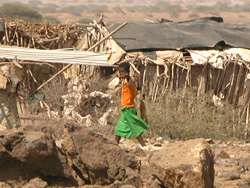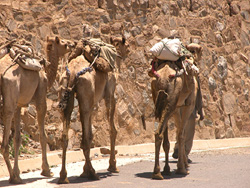From: Biniam Haile \(SWE\) (eritrea.lave@comhem.se)
Date: Fri May 08 2009 - 08:20:25 EDT
ERITREA: Climate-proofing for the future
ASMARA, 8 May 2009 (IRIN) - "Remember 'We Are the World'?" asked Mahmoud
Abdalla, a leader of the Hidareb ethnic community in Eritrea's arid
Anseba region along the northwestern border with Sudan, referring to the
1985 hit song by more than 40 top artists. "Remember the 1984 famine in
Ethiopia? This region was right in the middle of it."
In 1984 Eritrea was part of Ethiopia, where some of the song's proceeds
were spent.
Since then, droughts have grown longer and more brutal in this semi-arid
part of Africa, populated mainly by pastoralist communities.
According to climate change projections by the government, temperatures
could soar by more than 4 degrees Celsius by 2050, shrinking precious
sources of water such as boreholes and run-off - excess water from rain
or other sources flowing over the land - while droughts are expected to
become longer and more intense.
In its National Adaptation Programme of Action (NAPA), a plan to deal
with the effects of climate change, Eritrea has identified the livestock
production system and related livelihood opportunities for pastoralists
in the northwest as most vulnerable to climate change.
"When we had no food, we knew our children could survive on milk for
days, but over the years it has become difficult to find rangeland for
our animals, which has affected the livestock population - we don't even
have milk" said Abdalla.
Abdalla coordinates a pilot project to adapt livestock management to
climate change in the northwest.
The pilot project aims to bring water to three villages by harvesting
rainwater, and building a spate irrigation project to grow fodder for
livestock.
In spate irrigation, a system often used in semi-arid regions, flood
water is diverted from usually dry river beds and spread over large
areas, according to a project document by the Eritrean government and
the UN Development Programme (UNDP). This would prevent the flow from
causing damaging and wasteful "flash floods".
"The flood water - typically lasting a few hours or a few days - is
channelled through a network of primary, secondary and sometimes
tertiary flood channels. Command areas may range from a few hectares to
over 25,000 hectares," said Mogos Weldeyohannes, Director General of the
Department of Environment.
The project will be one of the first in Africa funded by the Least
Developed Countries Fund (LDCF), set up under the UN Framework
Convention on Climate Change to finance projects identified by countries
in their NAPA. Only a handful of NAPA projects have been approved for
implementation since the inception of the LDCF in 2001, according to
experts.
Bigger interests
But there are bigger interests riding on this project. Two-thirds of
Eritrea's 3.9 million people live in rural and semi-rural areas and the
government would like to keep it that way. "We do not have enough water
in the urban areas to support people who will move [if there is a severe
drought]," said Weldeyohannes.
Eritrea, one of the world's poorest countries, does not have the
resources to cope with the pressure on essential services, such as
health care, that the migration of large groups of people would bring.
The frequency and intensity of droughts is already forcing many
pastoralist families to move more often in search of pasture.
Traditional seasonal migration patterns and routes are being disrupted.
Pastoralists from the Anseba region trek long distances to the
neighbouring fertile Gash Barka area, where there are traditional
dry-season grazing reserves, according to the project document.
"The routes that pastoralists, including their livestock, use to travel
between seasons are well defined and based on known water points, feed
and tree shade. The movement involves mainly the larger animal species,
but in areas where heat stress is acute, all livestock species are
forced to migrate."
But, according to the government and UNDP, over time this traditional
coping practice has been disturbed by a number of factors, including
rising pressure from conflict over land use, land degradation, and new
government policies such as those on settling mobile people.
Another factor in government thinking is finding opportunities for
demobilised members of the Eritrean national services programme, said
Weldeyohannes. All Eritreans between the ages of 18 and 40 are part of
the national service programme, either as soldiers in the army, or on
infrastructure construction projects, or in the civil service. The
government is the biggest source of employment.
"Let's face it, we are at war with our neighbours and all these young
people will return one day," said Weldeyohannes. "What will happen then?
We cannot accommodate them in the urban centres such as Asmara, which
cannot cope with the half a million people already living there."
Theme(s): (IRIN) Environment, (IRIN) Natural Disasters
http://www.irinnews.org/report.aspx?ReportID=84285
<http://pictures.irinnews.org/images/2009/200905080929210980.jpg>
<http://www.irinnews.org/images/2009/200905080934580839.jpg>


----[This List to be used for Eritrea Related News Only]----